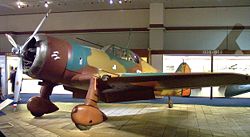Fokker D.XXI
| Fokker D.XXI | |
|---|---|
 Fokker D.XXI in the Soesterberg Museum Fokker D.XXI in the Soesterberg Museum
|
|
| Type: | Fighter plane |
| Design country: | |
| Manufacturer: | |
| First flight: |
March 27, 1936 |
| Number of pieces: |
148 |
The Fokker D.XXI was a fighter aircraft from the Dutch aircraft manufacturer Fokker from 1936.
development
The hunter was planned for use by the troops in the Dutch East Indies ( KNIL = Koninklijk Nederlandsch-Indisch Leger ). The plans provided for a cheap and stable fighter with medium performance.
The order for the Dutch East Indies was canceled by the Dutch Air Force ( Luchtvaart afdeling ) and 36 machines were ordered for domestic use. The first flight took place on March 27, 1936.
By the start of the western campaign , the attack by the Wehrmacht on the Netherlands on May 10, 1940, 36 machines had been delivered, 28 of which were operational. Although much weaker than the German Messerschmitt Bf 109 , the D.XXI was a serious opponent in aerial combat. The reason was the good maneuverability of the aircraft. However, all Fokker D.XXI were lost due to the superior strength of the German Air Force .
In 1937 the Finnish Air Force bought seven D.XXI . Between 1938 and 1944 Finland built another 93 machines under license. The D.XXI was already used in Finland during the winter war of 1939. The plane did very well against the Soviet Polikarpov I-15 and I-16 machines , especially in the harsh Finnish winter conditions. In winter, the undercarriage was often replaced with snow runners to enable take-offs and landings on frozen lakes. On one machine, the rigid chassis was replaced by a manually retractable chassis. However, this measure increased the performance of the aircraft only insignificantly, which is why there were no further conversions. Only in the later course of the war did the underpowered and only weakly armed D.XXI lag behind more modern Soviet fighters and was therefore mainly used as a reconnaissance aircraft.
Denmark and Spain bought further machines from 1938 or planned to build them under license. In the Spanish Civil War , the D.XXI was no longer used by the Republican government . The Finnish machines remained in service until 1948.
variants
- D.XXI
Prototype serial number FD-322
- D.XXI-1
Model aircraft delivered to Denmark , three built, powered by 645 hp (474 kW) Bristol Mercury VIS engines. Armed with 2 × 8 mm (0.315 in) machine guns and 2 × 20 mm (0.787 in) Madsen cannons
- D.XXI-1
Production aircraft built at the Royal Army Aircraft Factory, ten built with 830 hp (610 kW) Bristol Mercury VIII engines.
- D.XXI-2
53 built, 36 of which were delivered to the Netherlands (RNLAF).
- D.XXI-3
Finnish build of the D.XXI-2, 35 built
- D.XXI-4
Improved D.XXI-3, powered by 825 hp (607 kW) Pratt & Whitney R-1535-SB4C-G Twin Wasp Junior engines. Built: 55
- Project 150
Proposed version powered by a Bristol Hercules radial piston engine. Not built.
- Project 151
Proposed version powered by a Rolls-Royce Merlin piston engine. Not built.
- Project 152
Proposed version powered by a Daimler-Benz DB 600H engine. Not built.
Military users
-
 Denmark : 2 delivered and 10 built under license
Denmark : 2 delivered and 10 built under license -
 German Empire : some for testing after the occupation of the Netherlands
German Empire : some for testing after the occupation of the Netherlands -
 Finland : 7 delivered and 93 built under license
Finland : 7 delivered and 93 built under license -
 Netherlands : 36
Netherlands : 36 -
 Spain : one could before the end of the civil war are delivered
Spain : one could before the end of the civil war are delivered
Technical specifications
| Parameter | Data |
|---|---|
| crew | 1 |
| length | 8.20 m |
| span | 11.00 m |
| height | 2.95 m |
| Wing area | 16.20 m² |
| Empty mass | 1450 kg |
| Takeoff mass | 2050 kg |
| drive | an air-cooled 9-cylinder radial engine Bristol Mercury VIII with 830 PS (610 kW) |
| Top speed | 460 km / h |
| Service ceiling | 11,350 m |
| Range | 930 km |
| Armament | four machine guns FN -Browning M36, 7.92-mm |
Received aircraft
One example is now in the Militaire Luchtvaart Museum in Soesterberg , the Netherlands, and one in the Aviation Museum in Central Finland .


